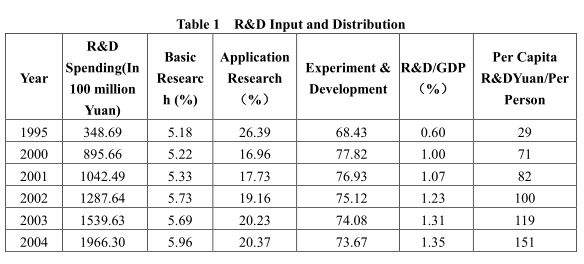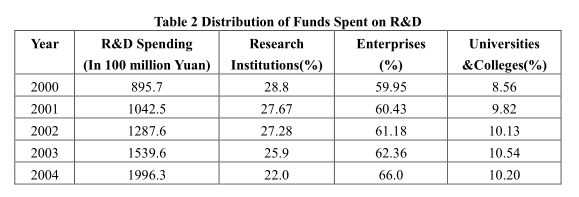Improving Institutional Building and Advancing Independent Innovation Capabilities
Jun 01,2006
By Lv Wei
Research Report No 060, 2006
The Proposal by the Central Committee of the Communist Party of China on Formulating the 11th Five-Year Plan for National Economic and Social Development pointed out that "the enhancing of the independent innovation capabilities should be taken as a key link of the strategic motif of scientific and technological development, the readjustment of industrial structure and the shift of the growth mode". The recently-released National Program of the Medium- and Long-term Development of Science and Technology (2006-2020) has outlined the goals of building a new-type state, and the priority tasks, key policies and measures regarding the reform of scientific and technological system and the building of a national innovation system. The key priority of the next phase is to open up a road of innovation catering to the national conditions of China by carrying out the strategy of independent innovation.
I. The Strategy of Technological Development of China Has Entered a New Phase
The economic globalization and knowledge-based economy have posed a challenge to the traditional industrial mode. The key factors determining the competitive advantages of industries have shifted from the conditions of natural resources and cheap labor in the past to innovative capabilities and the advantages of technology and management. With the rapid and sustained economic growth and the accelerated industrialization process, China has entered a historical period when it has to rely more on scientific progress and innovation to push forward the economic and social development. It has become a national strategy to raise the capabilities of independent innovation.
1. The technological development of China has shifted from the major practice of importing and copying technology to the combination of independent research and development (R&D) with the import of technology
Over quite a long period of time in the past, the source of technology of the majority of Chinese enterprises depended heavily on imported technology and imitation in manufacturing. The spending on R&D in China has outpaced the GDP growth since the late 1990s in the 20th century. In 2001, the spending on R&D exceeded 100 billion RMB yuan, accounting for more than 1% of the GDP of that year. The spending on R&D in 2004 amounted to 196.6 billion RMB yuan, making up for 1.23% of the GDP. Among the R&D spending, the proportion of basic research and application research registered a slight increase, and the technological supply capabilities have been improved steadily (See Table 1). The hi-tech industry has increased rapidly. The total output of the hi-tech industry witnessed an average annual growth rate of 25% during the 1995-2003 period. The export volume of hi-tech products accounted for 27.9% of the total foreign trade in 2004. Meanwhile, there emerged a number of dominating enterprises whose development and participation in international competition were driven by independent innovation.

2. The industrialization process has been accelerated and there is a pressing need for industrial technology to be upgraded
At present, some industries in our country have shifted from the production of low-end products to medium- and high-end ones, while other dominating enterprises have begun to emerge on international markets. They have faced fierce market competition from developed and industrialized countries. One the hand, it is impossible to import high-level technologies without the capabilities of independent research and innovation. On the other hand, it becomes more difficult to import technologies. The import of certain key and sensitive technologies, especially those concerning national security, has met with many restrictions. Therefore, it is imperative to rely on independent innovation to promote the upgrading of industrial technology and raise international competitiveness.
3. Enterprises have gradually played a greater role in technological innovation, but a new system of innovation in which enterprises are key players has yet to be put in place
As indicated by the distribution of funds spent on R&D, the proportion of spending of enterprises and universities has constantly been on the increase. In 2004, the R&D spending of enterprises accounted for 66% of the total of the whole country, while the figure of universities and colleges has been above 10% (See Table 2). Examined from an overall perspective, the proportion of spending of research institutions on R&D has exceeded 22%, higher than that of most countries in the world.

In terms of the source of R&D funds, the input of enterprises has outgrown that of the government. As far as the total amount of the R&D input is concerned, the proportion of the input by the government and enterprises is close to that of the U.S. and European countries. In 2003 and 2004, the R&D input by Chinese enterprises took up 60% and 65% of the total of the whole country. The figures of Britain, the 15EU states, OECD countries and the U.S. in this sector in 2003 were an average of 44%, 55%, 61% and 63%, respectively, while those of South Korea and Japan were 74% and 74.5%. The R&D input by the Chinese Government during the same period made up 30% and 26.6% of the total of the whole country. [1]

Compared with their revenues, the enterprise input on R&D remained at a lower level. Statistics showed that the average proportion of the R&D input by large and medium-sized enterprises accounted for 0.7% of their sales income between 2003 and 2004. In 2004, the input on R&D by enterprises above designated scale made up only 0.6% of their sales income, far below that of their peers in the developed countries.
Universities and research institutions maintained a relatively insignificant cooperation with enterprises. Currently, there existed a phenomenon of scientific technology divorced from economy. Universities and research institutions have developed an exclusive system of their own. On the one hand, their research achievements can hardly meet the demands of enterprises. On the other hand, there is a trend of research achievements being industrialized from within.
According to the Annual Report of World Competitiveness (2003), China ranked between 19th and 20th among 60 countries and regions in terms of its indicators of scientific and technological infrastructure, whereas it was in the 51st place in terms of its technological cooperation.
4. The opening-up drive remains at a high level while there is a strong dependence on foreign technology
Since China’s initiation of reform and opening-up, it has steadily opened wider to the outside world, which played a positive role in helping us attract foreign investment and learn from foreign technologies. However, we would become over-dependent on foreign technologies if we failed to pay attention to independent innovation. On the one hand, a considerable number of domestic enterprises have depended on imported technologies. Although China has become less dependent on foreign technologies in recent years, its rate of dependence is still more than 50%. On the other hand, foreign-funded enterprises have made a significant impact on the development of industrial technology. For instance, foreign funded enterprises accounted for about 50% of the imported technologies, while more than 80% of hi-tech products were exported by the foreign-funded enterprises. Multinational companies have established about 700 relatively independent R&D centers in China that have reached a certain scale. Their input on R&D was estimated to be about one-sixth or one-fifth of that of Chinese enterprises. The manufacturing industry transferred to China from abroad is still in the hand of foreign companies in terms of their core technology, brands and marketing channels.
…
If you need the full text, please leave a message on the website.
--------------------------------------------------------------------------------
[1] The foreign data were quoted from the statistics of 2003 as contained in The Scientific and Industrial Evaluation for Year 2005 –- OECD.














